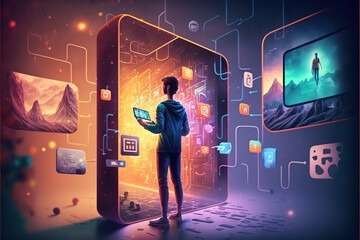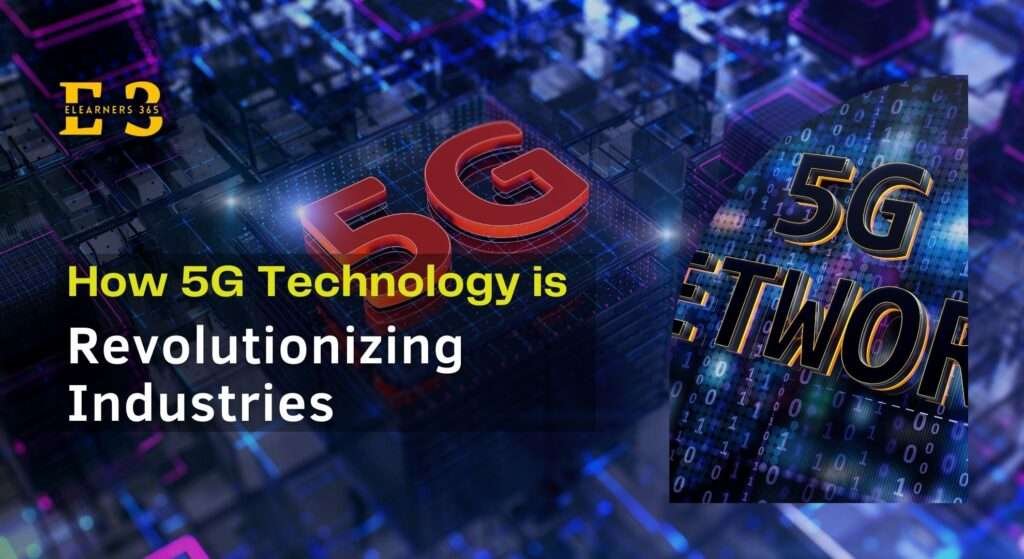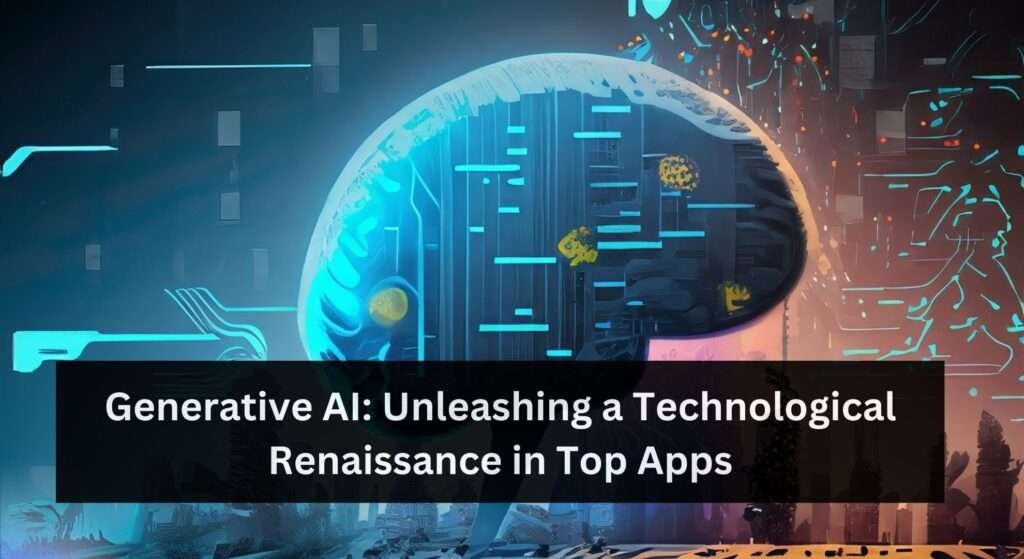How 5G Technology is Revolutionizing Industries
Introduction
In today’s digital age, staying connected is not just a luxury, but a necessity. As technology continues to advance, so does our need for faster, more reliable internet connections. This is where 5G comes into play – the fifth generation of wireless technology that promises to revolutionise our online experience. In this blog, we’ll explore how 5G internet is better than its predecessor, 4G, from an end-user perspective.
1.Lightning-Fast Speeds
Imagine downloading an HD movie in a matter of seconds or streaming your favorite TV show without any buffering. With 5G, these scenarios are no longer a distant dream. While 4G offered impressive speeds, 5G takes it up a notch, delivering download speeds that are up to 100 times faster. This means quicker downloads, smoother streaming, and seamless online gaming for users.
2. Low Latency for Real-Time Interactions

Latency refers to the delay between sending a command and receiving a response. In the world of online gaming, video conferencing, and remote applications, low latency is crucial for real-time interactions. 5G slashes latency to as low as 1 millisecond, making virtual experiences feel incredibly natural and responsive. No more frustrating lags during important video calls or multiplayer gaming sessions.
3. Enhanced Capacity and Connectivity
Have you ever been in a crowded area where your internet connection slowed to a crawl due to network congestion? 5G addresses this issue by offering enhanced capacity to accommodate a larger number of devices simultaneously. Whether you’re at a music festival, sports event, or a bustling city square, your connection will remain stable and fast, even during peak usage times.
4. Empowering IoT and Smart Devices
The Internet of Things (IoT) is transforming the way we interact with our surroundings, from smart thermostats to connected cars. 5G’s high-speed, low-latency capabilities are tailor-made for IoT devices, allowing them to communicate seamlessly and efficiently. This means your smart home devices will respond quicker, and the potential for innovative IoT applications is limitless.
5. Enriching Augmented and Virtual Reality

Augmented Reality (AR) and Virtual Reality (VR) are opening up new dimensions of entertainment, education, and business. 5G’s superior speeds and minimal latency create immersive experiences that are more realistic than ever. From virtual tours to remote medical consultations, 5G brings these technologies closer to our daily lives.
6. Fostering Innovation and Transformation

The launch of 5G doesn’t just enhance our current online experiences – it inspires innovation. Industries like healthcare, manufacturing, and transportation are exploring new possibilities thanks to 5G’s capabilities. Surgeons can perform remote surgeries, factories can achieve unprecedented levels of automation, and self-driving cars can communicate seamlessly with each other.
7. Seamless Streaming and Downloads
The launch of 5G doesn’t just enhance our current online experiences – it inspires innovation. Industries like healthcare, manufacturing, and transportation are exploring new possibilities thanks to 5G’s capabilities. Surgeons can perform remote surgeries, factories can achieve unprecedented levels of automation, and self-driving cars can communicate seamlessly with each other.
8. Buffer-Free Video Calls and Conferencing
Video calls have become a staple of modern communication, whether for work, catching up with loved ones, or collaborating on projects. 5G’s low latency ensures smooth, buffer-free video calls. No more awkward pauses mid-conversation or pixelated faces – just crystal-clear, real-time communication that bridges distances effortlessly.
9. Gaming without Limits
For gamers, lag can mean the difference between victory and defeat. 5G’s minimal latency ensures that your gaming experience is as responsive as possible. Engage in multiplayer battles, explore vast virtual worlds, and react to in-game events with split-second precision. With 5G, your reflexes will be the only thing determining your success.
10. Empowering Smart Cities and Homes
5G isn’t just about faster smartphones; it’s about transforming entire communities. Smart cities are leveraging 5G to connect devices that monitor traffic, manage energy consumption, and enhance public safety. Even within your own home, 5G enables a smarter living environment – from remotely adjusting your thermostat to receiving alerts from your security system.
11. Enriching Educational Experiences
As education increasingly moves online, reliable internet is a must. 5G’s high-speed connectivity ensures that students can access resources, attend virtual classes, and engage in interactive learning without disruptions. Whether you’re a student pursuing higher education or a parent assisting a young learner, 5G enhances the educational journey.
12. Pioneering Healthcare Innovations
Imagine a world where doctors perform surgeries from miles away and patients receive medical diagnoses through immersive virtual consultations. 5G’s low latency and high bandwidth enable these groundbreaking healthcare applications. From telemedicine to remote monitoring, 5G facilitates a healthier, more connected future.
Domain Specific Advancements :
1. Healthcare

- Remote Patient Monitoring: 5G enables real-time monitoring of patients’ vital signs and health data, facilitating timely interventions and reducing hospital visits.
- Telemedicine: High-quality video consultations and remote diagnostics become seamless, connecting doctors and patients regardless of distance.
- Surgery Assistance: Surgeons can perform procedures remotely with ultra-low latency, utilizing haptic feedback and robotics for precision.
2. Finance and Banking
- High-Frequency Trading: In financial markets, milliseconds matter. 5G’s low latency allows for lightning-fast execution of trades, enhancing efficiency.
- Secure Transactions: Faster and more secure transactions, coupled with advanced encryption, strengthen cybersecurity measures for financial transactions.
- Enhanced Customer Experience: Banks can offer real-time, personalized services through virtual assistance and interactive apps, improving customer engagement.
3. Space Exploration
- Remote Control: 5G aids in controlling space rovers, satellites, and other remote devices with minimal communication delays.
- Data Transmission: Transmitting large volumes of data collected from space becomes quicker and more efficient, enabling faster scientific analysis.
- Collaboration: Researchers around the world can collaborate seamlessly on space missions and experiments in real-time.
4. Manufacturing
- Industry 4.0: 5G powers the Industrial Internet of Things (IIoT), connecting factory machines, sensors, and equipment for real-time monitoring and automation.
- Predictive Maintenance: Sensors equipped with 5G connectivity can 3send data on machine health, enabling predictive maintenance to prevent downtime.
- Efficient Logistics: Autonomous vehicles within manufacturing plants and smart warehouses can navigate accurately and efficiently with 5G connectivity.
5. Automotive and Transportation
- Connected Vehicles: 5G enables vehicles to communicate with each other and infrastructure, enhancing road safety and reducing accidents.
- Autonomous Driving: Real-time data exchange among autonomous vehicles ensures safer navigation and smoother traffic flow.
- Entertainment and Passenger Services: High-speed 5G connectivity within vehicles enhances in-car entertainment and facilitates passenger connectivity.
6. Agriculture

- Precision Farming: 5G-enabled sensors collect data on soil moisture, crop health, and weather conditions for optimized irrigation and planting.
- Livestock Monitoring: Livestock can be tracked and monitored in real-time, improving animal welfare and farm management.
- Drones and Robotics: 5G enhances the efficiency of agricultural drones and robots for tasks like crop spraying, monitoring, and harvesting.
7. Energy and Utilities
- Smart Grids: 5G enables real-time monitoring of energy consumption and distribution, optimizing power grids for efficiency and reliability.
- Remote Maintenance: Utilities can remotely monitor and maintain equipment, reducing downtime and enhancing the efficiency of energy generation.
- Environmental Monitoring: Sensors connected through 5G assist in monitoring air and water quality, contributing to environmental protection.
8. Entertainment and Media
- Immersive Experiences: 5G enhances virtual reality (VR) and augmented reality (AR) experiences, providing users with ultra-realistic and interactive content.
- Live Streaming: Buffer-free, high-definition live streaming becomes feasible, revolutionizing the way events are broadcasted and consumed.
- Interactive Gaming: Multiplayer gaming experiences are elevated with 5G’s low latency, offering seamless and responsive gameplay.
These are just a few examples of how 5G is poised to transform various industries by providing specific advantages tailored to their unique needs and challenges. As 5G continues to roll out and innovations unfold, its impact on these sectors will likely become even more profound.



